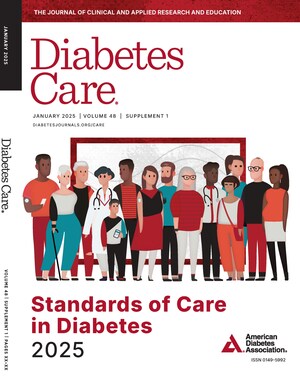SAN FRANCISCO, June 9, 2019 /PRNewswire/ -- Children with early-onset type 1 diabetes (T1D) and poor glycemic control have slower growth of areas in the brain associated with mild cognitive deficits compared to children without diabetes, according to the study, "ADA Presidents' Select Abstract: Type 1 Diabetes and the Developing Brain—A Longitudinal Study of Brain Growth by the Diabetes Research in Children Network (DirecNet)," presented today at the American Diabetes Association's® (ADA's) 79th Scientific Sessions® at the Moscone Convention Center in San Francisco. The study found that children with early-onset T1D have mild but significant differences in total brain and regional gray and white matter growth compared to children without diabetes.
Over time, T1D can cause complications in multiple organ systems, including the retina, cardiovascular, kidneys and peripheral nervous system. Research also suggests the glycemic fluctuations of hypoglycemia and hyperglycemia associated with T1D can negatively affect brain development. Despite improved glycemic control due to emerging technologies and newer insulins, growing evidence demonstrates that individuals with T1D are at risk for cognitive dysfunction.
As part of a multi-site study of the Diabetes Research in Children Network (DirecNet), researchers aimed to determine the extent to which glycemic exposure adversely impacts the developing brain in children with early-onset T1D. The study enrolled 138 children with T1D with a median age of seven years. The participants had a disease duration on average of 2.4 years at the beginning of the study. Researchers conducted structural magnetic resonance imaging (MRI) studies on the participants' brains and compared the results to those of a control group consisting of 66 age-matched children (average age of seven years) who did not have diabetes.
The MRIs were performed at three time points (baseline, 18 months and approximately 2.9 years after the second visit), and white matter (WM) and gray matter (GM) volumes in various brain regions-of-interest were determined. Total cumulative hyperglycemic exposure was determined (lifetime HbA1c) from the time of diagnosis in the T1D group.
Researchxers found that the group with T1D had slower growth of total cortical and subcortical GM and WM than the control group at all time points. A set of metabolically active brain regions that form the "default mode network," which is associated with other brain disorders, showed less growth in the T1D group compared to the control group. These regions of slower growth were associated with higher lifetime HbA1c values.
"With an ever-increasing number of people living to old age, diabetes-related cognitive dysfunction could have challenging future public health implications," said Nelly Mauras, MD, co-principal investigator, chief of the division of endocrinology, diabetes & metabolism at the Nemours Children's Health System in Jacksonville, Florida, and professor of pediatrics at the Mayo College of Medicine. "Although there have been advances in new insulin and technologies that can significantly improve care, children with diabetes are still exposed to significant hyperglycemia and hypoglycemia, which will continue to confer a risk to the brain. The young children with type 1 diabetes in our study had significant differences in brain structure and growth compared to the control group, and poor glycemic control may increase risk for changes in brain structure over time. However, the variability in outcomes remains unexplained. Therefore, understanding these early effects is a necessary step towards understanding effects later in adulthood and in developing strategies for reducing risk of brain-associated complications in type 1 diabetes. Whether scrupulous maintenance of near-normoglycemia with advanced diabetes technologies will have a positive impact on these findings is being actively investigated."
To speak with Dr. Mauras or Dr. Allan Reiss, co-principal investigators, please contact the ADA Press Office on-site at the Moscone Convention Center on June 7-11, by phone at 415-978-3606 or by email at [email protected].
The American Diabetes Association's 79th Scientific Sessions, the world's largest scientific meeting focused on diabetes research, prevention and care, in being held June 7-11, 2019, at the Moscone Center in San Francisco, California. Nearly 15,000 leading physicians, scientists, health care professionals and industry representatives from around the world have convened at the Scientific Sessions to unveil cutting-edge research, treatment recommendations and advances toward a cure for diabetes. During the five-day meeting, attendees receive exclusive access to more than 850 presentations and 2,000 original research presentations, participate in provocative and engaging exchanges with leading diabetes experts, and can earn Continuing Medical Education (CME) or Continuing Education (CE) credits for educational sessions. The program is grouped into eight thematic areas: Acute and Chronic Complications; Behavioral Medicine, Clinical Nutrition, Education and Exercise; Clinical Diabetes/Therapeutics; Epidemiology/Genetics; Immunology/Transplantation; Insulin Action/Molecular Metabolism; Integrated Physiology/Obesity; and Islet Biology/Insulin Secretion. Gretchen Youssef, MS, RDN, CDE, President of Health Care and Education, delivered her address, "It's All About Access!," on Saturday, June 8, and Louis H. Philipson, MD, PhD, FACP, President of Medicine and Science, will deliver his lecture, "Precision Medicine—Addressing the Many Faces of Diabetes," on Sunday, June 9. Join the Scientific Sessions conversation on social media using #ADA2019.
About the American Diabetes Association
Every day more than 4,000 people are newly diagnosed with diabetes in America. Nearly 115 million Americans have diabetes or prediabetes and are striving to manage their lives while living with the disease. The American Diabetes Association (ADA) is the nation's leading voluntary health organization fighting to bend the curve on the diabetes epidemic and help people living with diabetes thrive. For nearly 80 years the ADA has been driving discovery and research to treat, manage and prevent diabetes, while working relentlessly for a cure. We help people with diabetes thrive by fighting for their rights and developing programs, advocacy and education designed to improve their quality of life. Diabetes has brought us together. What we do next will make us Connected for Life. To learn more or to get involved, visit us at diabetes.org or call 1-800-DIABETES (1-800-342-2383). Information is available in English and Spanish. Join the fight with us on Facebook (American Diabetes Association), Twitter (@AmDiabetesAssn) and Instagram (@AmDiabetesAssn).
209-OR Type 1 Diabetes and the Developing Brain—A Longitudinal Study of Brain Growth by the Diabetes Research in Children Network (DirecNet)
79th Scientific Sessions
News Briefing: Evolving Concepts in Type 1 Diabetes, Sunday, June 9, 12:00 p.m. - 1:00 p.m.
Session Type: Oral Presentations
Session Title: From Risk to Complications of Type 1 Diabetes Youth—What's New? (With ADA Presidents' Select Abstract Presentation)
Location: S-10 (South, Exhibition Level)
Session Time: Sunday, June 9, 2019, 4:30 pm - 6:30 pm
ANA MARIA ARBELAEZ, STEFANI O'DONOGHUE, NELLY MAURAS, BRUCE A. BUCKINGHAM, NEIL H. WHITE, STUART A. WEINZIMER, TANDY AYE, EVA TSALIKIAN, DARRELL M. WILSON, WILLIAM V. TAMBORLANE, MICHAEL TANSEY, ALLISON CATO, TAMARA HERSHEY, LARRY A. FOX, KIMBERLY A. ENGLERT, ALLAN L. REISS, St. Louis, MO, Stanford, CA, Jacksonville, FL, Palo Alto, CA, New Haven, CT, Iowa City, IA
Background: The extent to which glycemic exposure adversely impacts the developing brain in young children with early-onset type 1 diabetes (T1D) is controversial.
Methods: As part of the multisite DirecNet Study, we performed structural MRI at three time points (baseline, 18 months and approximately 2.9 years after the second visit) in 137 children with T1D (age: 7.0 ± 1.7 years, lifetime average HbA1c: 8.0 ± 0.7%, and diabetes duration: 2.4 years at study entry) and 66 age-matched nondiabetic controls (7.0 1.8 years old). White matter (WM) and gray matter (GM) volumes in various brain regions-of-interest were determined by voxel-based morphometry (VBM). Total cumulative hyperglycemic exposure was determined as HbA1c area under the curve (lifetime A1c) from the time of diagnosis in T1D children.
Results: Children with T1D had slower growth of total cortical and subcortical GM and WM than the nondiabetic controls at all timepoints. Gray matter regions (frontal, temporal, subcortical, and occipital cortex) showed less growth in the T1D compared to the control group (p<0.05 family wise error (FWE)-corrected), as did white matter areas (temporal, parietal, and occipital white matter) (p<0.05 FWE-corrected). The occipital-cerebellar and basal ganglia regions appeared to be most vulnerable to the effects of T1D in children. The regions of slower growth were associated with higher lifetime A1c values (p<0.05 false discovery rate (FDR)-corrected).
Conclusion: This study demonstrates that children with early-onset T1D and worse glycemic control have slower cortical and subcortical GM and WM growth than nondiabetic controls, suggesting that hyperglycemia is detrimental to the developing brain during this critical period of rapid brain maturation. The long-term consequences of these early alterations in brain growth require further follow-up.
Author Disclosure Block: A.Arbelaez: None. W.V.Tamborlane: Consultant; Self; AstraZeneca, Boehringer Ingelheim International GmbH, Eli Lilly and Company, Medtronic MiniMed, Inc., Novo Nordisk Inc., Sanofi, Takeda Pharmaceutical Company Limited. M.Tansey: Advisory Panel; Self; Daiichi Sankyo Company, Limited. A.Cato: None. T.Hershey: Research Support; Spouse/Partner; Sage Pharmaceuticals. L.A.Fox: None. K.A.Englert: Consultant; Self; PicoLife Technologies, LLC. A.L.Reiss: None. S.O'donoghue: None. N.Mauras: Consultant; Self; Novo Nordisk Inc., PicoLife, Research Support; Self; Medtronic MiniMed, Inc. B.A.Buckingham: Advisory Panel; Self; ConvaTec Inc., Novo Nordisk Inc., Profusa, Inc., Consultant; Self; Medtronic MiniMed, Inc., Other Relationship; Self; Insulet Corporation, Tandem Diabetes Care, Research Support; Self; Beta Bionics, ConvaTec Inc., Dexcom, Inc., Insulet Corporation, Medtronic MiniMed, Inc., Tandem Diabetes Care. N.H.White: None. S.A.Weinzimer: Consultant; Self; Eli Lilly and Company, Sanofi, Zealand Pharma A/S, Consultant; Spouse/Partner; Tandem Diabetes Care, Speaker's Bureau; Self; Insulet Corporation, Medtronic MiniMed, Inc., Tandem Diabetes Care, Stock/Shareholder; Self; InsuLine Medical Ltd. T.Aye: None. E.Tsalikian: None. D.M.Wilson: Advisory Panel; Self; Tolerion, Inc., Research Support; Self; Beta Bionics, Dexcom, Inc., Medtronic.
Contact:
Michelle Kirkwood
(703) 299-2053
[email protected]
SOURCE American Diabetes Association

Related Links
WANT YOUR COMPANY'S NEWS FEATURED ON PRNEWSWIRE.COM?
Newsrooms &
Influencers
Digital Media
Outlets
Journalists
Opted In






Share this article